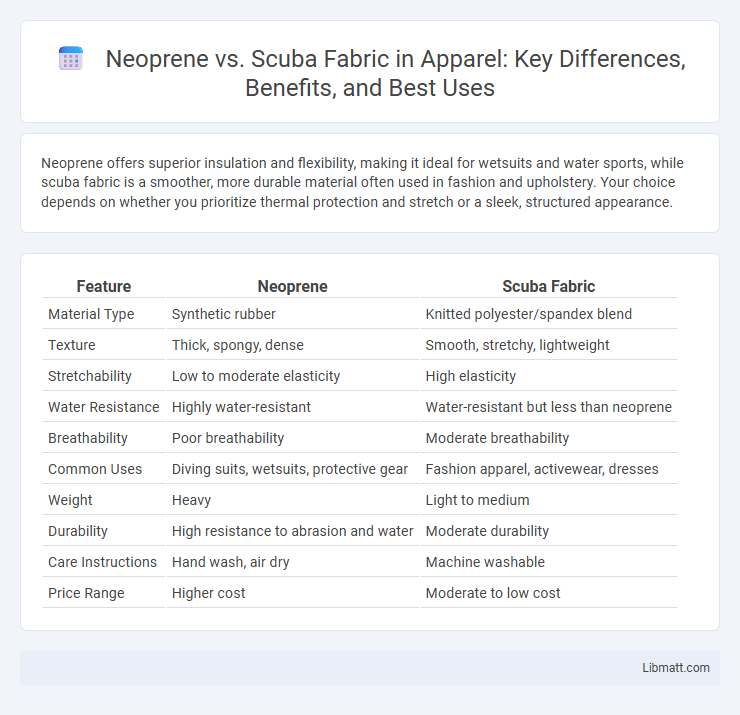Neoprene offers superior insulation and flexibility, making it ideal for wetsuits and water sports, while scuba fabric is a smoother, more durable material often used in fashion and upholstery. Your choice depends on whether you prioritize thermal protection and stretch or a sleek, structured appearance.
Table of Comparison
| Feature | Neoprene | Scuba Fabric |
|---|---|---|
| Material Type | Synthetic rubber | Knitted polyester/spandex blend |
| Texture | Thick, spongy, dense | Smooth, stretchy, lightweight |
| Stretchability | Low to moderate elasticity | High elasticity |
| Water Resistance | Highly water-resistant | Water-resistant but less than neoprene |
| Breathability | Poor breathability | Moderate breathability |
| Common Uses | Diving suits, wetsuits, protective gear | Fashion apparel, activewear, dresses |
| Weight | Heavy | Light to medium |
| Durability | High resistance to abrasion and water | Moderate durability |
| Care Instructions | Hand wash, air dry | Machine washable |
| Price Range | Higher cost | Moderate to low cost |
Introduction to Neoprene and Scuba Fabric
Neoprene is a synthetic rubber material known for its excellent insulation, flexibility, and durability, commonly used in wetsuits and protective gear. Scuba fabric, on the other hand, is a type of double-knit fabric made from polyester and spandex, offering a smooth, stretchy texture often used in fashion and activewear. Understanding the distinct properties of neoprene and scuba fabric helps you select the right material for insulation, comfort, and style in your projects.
Fabric Composition and Structure
Neoprene is a synthetic rubber composed of chloroprene polymer, known for its closed-cell foam structure that provides superior insulation and buoyancy, making it ideal for wetsuits and diving gear. Scuba fabric, often used interchangeably with neoprene, typically refers to a double-knit fabric laminated to a neoprene core, offering a smooth, durable outer surface while retaining neoprene's flexibility and thermal properties. Your choice between neoprene and scuba fabric depends on the need for stretch, thickness, and environmental resistance in water sports apparel.
Manufacturing Process Overview
Neoprene is produced through a polymerization process involving chloroprene monomers, which are then foamed and cured to form a flexible, durable synthetic rubber with a closed-cell structure ideal for insulation. Scuba fabric is created by laminating neoprene to a double-knit outer layer, enhancing its aesthetic appeal and providing additional strength and stretch for activewear or fashion applications. Your choice between neoprene and scuba fabric depends on whether you prioritize pure thermal insulation or a combination of flexibility, texture, and appearance.
Key Physical Properties Compared
Neoprene offers superior elasticity and thermal insulation compared to scuba fabric, making it ideal for wetsuits and diving gear. Scuba fabric, while similar in appearance, is lighter, less flexible, and lacks the closed-cell structure that provides neoprene its buoyancy and water resistance. Your choice depends on the need for warmth, flexibility, and durability in aquatic environments.
Durability and Longevity
Neoprene exhibits superior durability and longevity compared to scuba fabric due to its closed-cell structure that resists abrasion, UV damage, and chemical exposure. Scuba fabric, while flexible and smooth, tends to wear out faster under intense use and exposure to elements like saltwater and sunlight. Choosing neoprene ensures prolonged performance in wetsuits, diving gear, and other applications demanding resilience.
Comfort and Breathability
Neoprene offers superior insulation but tends to be less breathable, often causing heat and moisture buildup during extended wear. Scuba fabric provides a smoother, more flexible texture that enhances comfort and allows better airflow, reducing sweat accumulation. For activities requiring prolonged movement and ventilation, scuba fabric is generally preferred for its breathable properties.
Water Resistance and Insulation
Neoprene offers superior water resistance due to its closed-cell foam structure, making it highly effective at preventing water absorption and retaining body heat. Scuba fabric, often crafted from tightly woven nylon or polyester with a smooth surface, provides moderate water resistance but lacks the same insulating properties as neoprene, which contains tiny gas bubbles to trap warmth. Your choice between neoprene and scuba fabric should consider neoprene's enhanced insulation for cold water activities versus scuba fabric's lighter, more flexible feel with less thermal protection.
Common Applications and Uses
Neoprene is widely used in wetsuits, gloves, and orthopedic braces due to its excellent insulation and flexibility, making it ideal for water sports and medical applications. Scuba fabric, a type of double-knit polyester, is favored for fashion apparel, activewear, and accessories because of its smooth texture, durability, and ease of sewing. Your choice between neoprene and scuba fabric depends on whether you prioritize thermal protection or lightweight, breathable material for apparel and accessories.
Cost Considerations
Neoprene typically offers a more affordable option for wetsuits and diving gear compared to traditional scuba fabric, which can be pricier due to its specialized materials and durability. Your choice should factor in budget constraints alongside the expected use and longevity, as neoprene provides excellent insulation at a lower cost while scuba fabric excels in resistance and flexibility but at a higher price point. Investing in neoprene saves on initial expenses, whereas scuba fabric may reduce replacement frequency, impacting overall cost efficiency.
Which Fabric Is Better for Your Needs?
Neoprene offers excellent insulation and flexibility, making it ideal for water sports and cold environments, while scuba fabric is thicker and smoother, providing a stylish look and better durability for fashion and casual wear. Your choice depends on whether you prioritize performance and warmth with neoprene or comfort and aesthetics with scuba fabric. Scuba fabric's resistance to wrinkles and ease of care make it better suited for everyday wear, whereas neoprene is unmatched in thermal protection and stretch.
Neoprene vs scuba fabric Infographic

 libmatt.com
libmatt.com